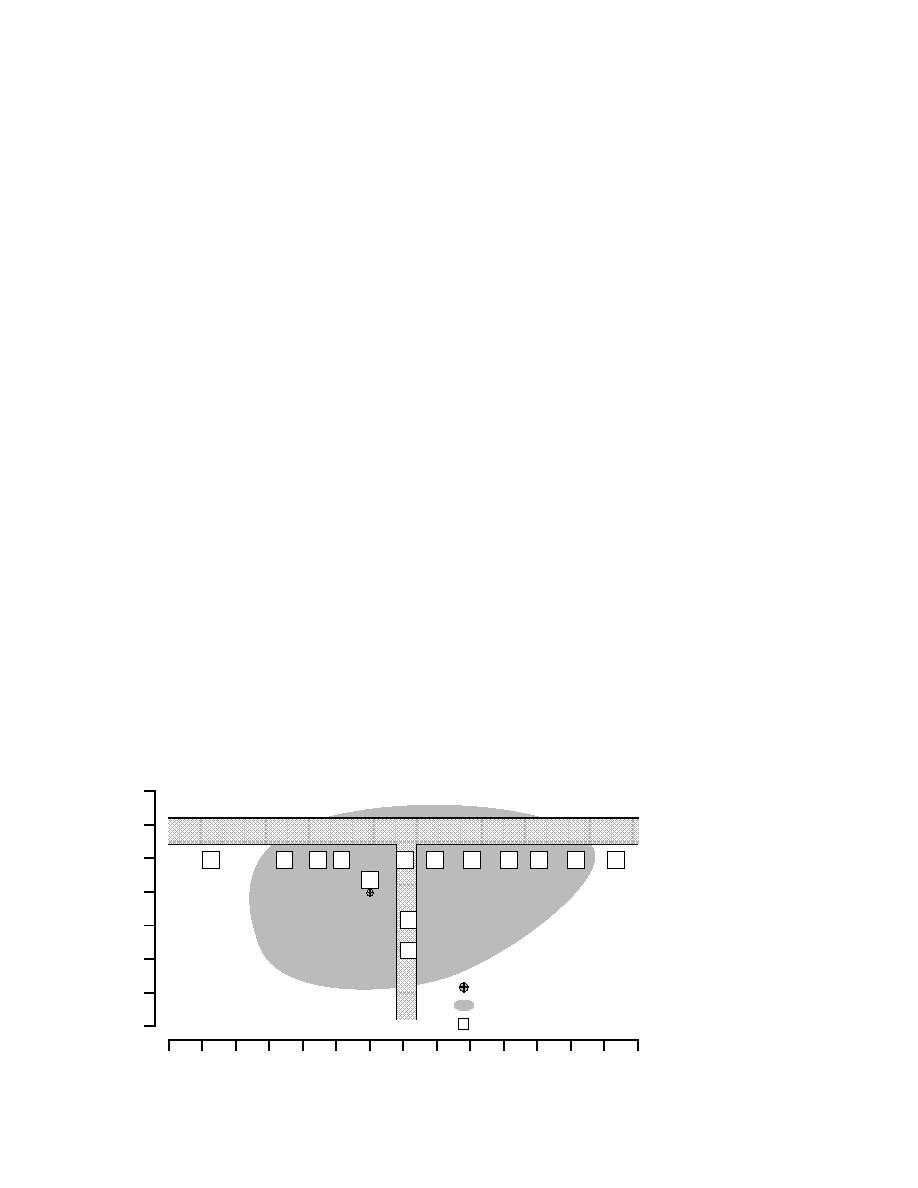
PMA-2 mines, while 2,4,6-TNT was present at 82.4%
ues appear to be due to the presence of a small particle
in this explosive (George et al. 1999). Thus we do not
of explosive because they are so much higher than the
believe the 2,4-DNT found in the crater originated from
other surface samples analyzed. Nevertheless, there
the explosive in the mine. More likely it was present in
appears to be a halo of higher concentrations of TNT
the soil below the detonation because of propellant con-
about 3 m from the crater extending to about 18 m down-
tamination from previous range activities. This experi-
wind from the detonation. Very low amounts of TNT
ment was conducted in early spring and the surface soil
were found in the crater sample, upwind (west) of the
under the snow cover was thawed. This result reinforc-
detonation, and outside the area of visible soot deposi-
es our concern about conducting these types of tests on
tion (Fig. 2). The very low concentration of TNT in the
soil at ranges where other testing and training activi-
crater sample agrees with results from Collins and
ties have occurred.
Calkins (1995), who reported that concentrations were
Although tetryl was found in the sample of explo-
below method detection limits for samples taken from
sive taken from a PMA-2 land mine by George et al.
a crater formed by a mortar detonation in snow.
The highest RDX concentration, 11.87 g/m2, was
(1999) at 17.4%, it was not detected in the residues af-
ter detonation in this study. Tetryl was probably present
found in sample S-8C, which was collected about 1 m
as the booster in the mine that was sampled by George
from the crater (Fig. 3), although the concentration in
et al. and had been replaced with RDX in the specific
the sample from the crater itself was quite low. The
mine we detonated at CEATS.
halo of higher concentration found for TNT was not
The two most commonly encountered environmental
evident in the surface RDX concentrations, and con-
transformation products of TNT (2-ADNT and 4-ADNT)
centrations upwind were generally as high as those
were also found in a few surface snow samples (Table
downwind. The reason for the different distribution
5). It is possible that a portion of these products was
pattern is unclear, but RDX is present in this mine in
formed in the meltwater prior to analysis rather than in
the booster and is not present in the main charge.
the snow since they were found in the samples with the
The distribution of 2,4-DNT in the surface snow
highest TNT concentration. 2-ADNT and 4-ADNT were
samples is presented in Figure 4. The pattern is fairly
also found in the crater sample, but their presence in
similar to that for TNT, with a region of highest con-
this sample is likely due to previous range activities.
centrations from 1 to 10 m from the detonation crater.
For 2,4-DNT, however, a relatively high mass (48 g)
Estimated surface soil concentrations
was detected in the sample of snow from the detona-
resulting from a land-mine detonation
tion crater, and 2,4-DNT was not found in sample S-
If no snow was present at the time of a land-mine
1S, the sample that had the highest concentration of
detonation, the residues produced would be deposited
TNT. The mass of 2,4-DNT recovered from the crater
on the surface soil. If we assume a soil depth of 0.5 cm
was 50 times the mass of TNT found in this sample.
and an average soil density of 1.7 g/cm3, we can esti-
2,4-DNT is present at only 0.025% in the TNT used in
North
2,4-DNT (g m2)
m
9
Gravel Road
6
3
S-6
S-5
S-4
S-3
S-2
S-1
S-1
S-2
S-3
S-4
S-7
E
E
E
E
E
E
W
W
W
W
E
1.53
<d
<d
<d
0.38
1.29
1.38
2.00
0.33
<d
<d
<d
S-8
0
S-2 <d
Figure 4. Spatial distribution of
3
S
2,4-DNT in surface snow samples
S-1
(g m2).
S 0.5
6
Detonation Crater
9
≈
Visible Plume = 381 m2
Grassy Road
≈
Area Sampled = 2.3 m2
12
South
18
15
12
9
6
3
0
3
6
9
12
15
18
21
24 m
West
East
7



 Previous Page
Previous Page
